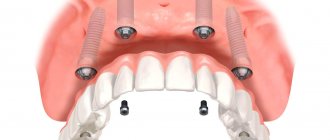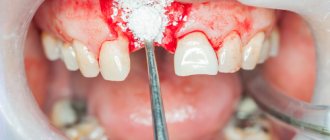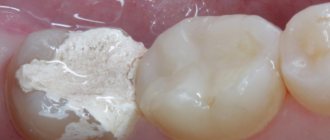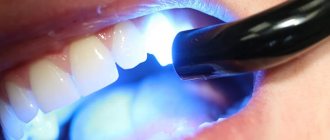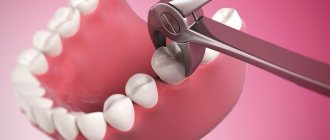To ensure painless dental treatment, local anesthesia is usually used in dentistry - it is used when performing almost all dental procedures to provide the patient with the most comfortable and painless conditions while in the dental chair. Local anesthesia in dentistry allows you to temporarily block in a certain area the transmission of nerve impulses that signal the brain about the impact on a tooth, so a person does not feel pain during treatment procedures. In this case, the effect of the anesthetic extends only to the peripheral nervous system, without affecting the brain: the patient remains fully conscious.
There are several different types of this kind of anesthesia; the doctor chooses a certain type depending on the volume of the upcoming intervention, the localization of the pathological process and the general condition of the patient’s body. You also need to know that in some cases the patient is given some preparation for local anesthesia - it is necessary for him to endure this procedure as comfortably as possible.
Types of anesthesia in dentistry
Anesthesia in dentistry can be general or local. The first includes intravenous sedation, as well as general anesthesia. That is, the drugs do not act locally in the oral cavity, but throughout the entire body. Actually, this is ordinary general anesthesia, which is used everywhere in medicine - it’s just that certain types are used in dentistry. Local, as it is already becoming clear, includes the familiar “freezing”, which is administered by injection.
Separately, we can also distinguish xenon sedation or xenon therapy - the second name will be even more correct, since such anesthesia is used to prepare for local or general anesthesia. It allows you to reduce the level of anxiety and stress, saturates the body's cells with oxygen, due to which it has a general healing and even rejuvenating effect! It is not an independent type of pain relief, but is used in combination with other approaches.
Possible complications
In the practice of specialists at the World of Dentistry clinic, severe complications after conduction anesthesia occur in extremely rare cases. Negative effects include neuropathy and an inadequate response of the body to the administered drug. Complications that are normal and go away on their own include:
- Muscle weakness.
- Goosebumps effect.
- Partial loss of sensitivity.
The above symptoms disappear without a trace a maximum of a month after the procedure. Damaged nerves are completely restored.
Xenon sedation or xenon therapy to prepare for main anesthesia
This is a separate type of anesthesia that can be used in combination with both local and general anesthesia (if necessary). Xenon is an inert gas that quickly begins to act and is just as quickly eliminated from the body. It has a relaxing effect: anxiety decreases, the patient relaxes. Moreover, during the operation he is fully conscious, can communicate with the doctor, and understands everything that is happening around him. The procedure can be interrupted if necessary if there is discomfort. At the same time, local anesthetics are used, since xenon itself does not have a pronounced analgesic effect.
Among the pleasant “bonuses” are saturation of cells with oxygen and restoration of metabolic processes. That is, this is not only a reduction in stress, but also a general improvement in the body’s health.
General anesthesia in dentistry
With general anesthesia, the patient falls asleep for 1-2 hours or more, i.e. for the entire duration of treatment. The drug is administered intravenously, less often by inhalation. If possible, general anesthesia should still be avoided, since its effect on many organs is quite toxic. Even despite the fact that dentistry uses “lighter” drugs than during complex surgical operations. This is a fairly large load on the body, especially on the heart, nervous and cardiovascular systems.
Intravenous sedation
Intravenous sedation does not have such pronounced negative consequences for the body. Softer and gentler drugs are used here. Sedation puts a person into a half-asleep state - the patient can respond to the doctor’s commands, communicate and understand him. At the same time, the person is completely relaxed and may even fall asleep for several hours. Thus, intravenous sedation is a more gentle and safe type of pain relief.
This is interesting! The word “sedation” itself means “calming.” It can be carried out either by inhalation (nitrous oxide or safer and more effective xenon is used for this), as well as intravenously with the selection of drugs strictly individually.
We treat without pain and discomfort!
Intravenous sedation
Safe and pain-free Treatment in your sleep Quick recovery from RUB 8,000. from 8,000 rub.
Xenon sedation
Relaxation before treatment No stress on the body Recovery in 2-3 minutes from RUB 5,000. from 5,000 rub.
With us you will stop being afraid of dentists! Individual selection of drugs, the most modern equipment and certified doctors who professionally work with all types of anesthesia.
Enroll now
Expert opinion
Emir Romanovich Omerelli
Maxillofacial surgeon, implantologist
Experience: more than 13 years
As can be seen from the above, pregnancy is a factor that excludes almost all types of anesthesia during treatment. Some experts believe that it is possible to use painkillers for dental treatment during pregnancy, but only if they do not contain adrenaline. And yet, before starting treatment with anesthesia, you need to decide whether it is really necessary in each specific case, and, if you cannot do without it, use local anesthetics. It is also worth assessing the level of necessity and appropriateness of the procedures, for example, teeth whitening is not necessary, and it is better to postpone it. There is no special anesthetic drug for pregnant women.
Currently, dentistry has a wide selection of drugs and anesthesia technologies. This allows treatment to be carried out with maximum comfort for the patient and the doctor. However, we should not forget about the risks of negative consequences, and make a decision about using anesthesia after carefully weighing all the pros and cons. Local anesthesia is by far the most preferred choice.
Other jobs
What is local anesthesia?
Local anesthesia allows you to numb the specific area where the intervention is planned. The patient is conscious. And this is actually more than enough even for complex surgical operations.
For local administration of all types of anesthetics, special reusable syringes are used, which have a recess for inserting a carpule - this is a hermetically sealed ampoule with an anesthetic. Unlike disposable ones, carpule syringes have a thinner needle, which allows you to administer the drug slowly and thus eliminate pain. All syringes for reusable use must undergo antiseptic treatment and sterilization using modern ultrasonic and temperature sterilization equipment.
Central conduction anesthesia
Pterygopalatine anesthesia involves the injection of a solution into the pterygopalatine fossa. This fossa lies between the upper jaw and the pterygoid process of the sphenoid bone. It is safer to insert a needle into the pterygopalatine fossa than into the foramen rotundum.
Possible routes of pain relief
- palatine, when the needle is inserted through the greater palatine foramen and moved along the pterygopalatine canal, numbing the maxillary nerve;
- tuberous, when the solution is released near the maxillary tubercle and along the bone;
- orbital, when the skin above the bone of the anterior wall of the lower orbital margin is pierced, the solution is injected behind it;
- subzygomatic-pterygoid, when the needle is inserted into the middle of the trago-orbital line at the lower wall of the zygomatic arch, the anesthetic is injected into the outer plate of the pterygoid process, as well as into the pterygopalatine fossa.
Another method of central conduction anesthesia is anesthesia at the foramen ovale. It is located in the medial posterior part of the infratemporal fossa. The fossa itself is a depression on the side wall of the skull.
Methods for anesthetizing the foramen ovale
- subzygomatic, when a puncture is made in the middle of the trago-orbital line, deepened to the outer plate of the pterygoid process, through which they enter the foramen ovale;
- suprazygomatic, when the needle is inserted through the trago-orbital line, deviating downwards;
- mandibular, when the needle is passed along the inner surface of the branch, the end is retracted to the bone wall;
- orbital, when the lower edge of the orbit near the inferior outer corner is pierced, the needle penetrates the infratemporal fossa through the lateral region of the inferior orbital fissure.
Infiltration anesthesia
Classic “freezing”, which is used in dentistry for almost any manipulation. The drug is injected under the mucosa, into the periosteum or directly into the bone. Depending on the procedure and the patient’s pain threshold, the required dosage is selected - for example, in case of acute pulpitis or complex tooth extraction, a higher concentration of the drug is used. If the patient is afraid of injections, topical anesthesia can additionally be used to numb the site of needle insertion, or xenon sedation.
When performing the procedure, the doctor must take into account the anatomy of the jaw system. For example, in the lower jaw the alveolar bone is denser, so anesthesia is less effective. In the upper jaw, when performing manipulations in the area of wisdom teeth, there is a risk of the needle touching one of the branches of the facial nerve, which is fraught with the development of neuralgia. The clinic’s doctors have the necessary qualifications, so even the most complex anesthesia is performed completely safely for the patient.
Use in dental practice
An anesthetic drug is injected into an area located a short distance from the site where surgery will be performed.
Conduction anesthesia can be performed in one of two ways:
- Central. The doctor determines the main trunks of the nerve endings for subsequent administration of the medicine into one of them.
- Peripheral. The anesthetic is injected into one of the branches of the main nerve of the stem system.
High-quality pain relief involves delivery of the solution to its destination. We are talking about a canal - a bone opening through which the nerve ending passes.
Preparations for local anesthesia
The Smile-at-Once clinic uses modern anesthetics of the latest generation - effective, non-toxic and absolutely safe, even for pregnant women, the elderly or children. We do not use drugs based on novocaine or lidocaine due to toxicity and a high risk of allergic reactions. In addition, the articaine group of drugs, which are used today for local anesthesia, are 5-6 times more effective than lidocaine.
"Ultracaine" for all groups of patients
An original drug produced in France, which is used for both infiltration and conduction anesthesia.
It is safe, used even in the presence of allergic reactions, and is suitable for patients with heart disease and pregnant women. Its effectiveness is very high, while it is instantly eliminated from the body and does absolutely no harm. The main active ingredient is articaine, to which epinephrine is added to enhance the anesthetic and prolong its action. It provides local vasoconstriction, which significantly shortens the rehabilitation period after treatment. Depending on the concentration of epinephrine, there are three types of the drug - for different manipulations and categories of patients.
"Ultracaine-Forte" (concentration 1:100,000) is a drug with a high dose of epinephrine, used during surgical operations. "Ultracaine DS" with a low concentration (1:200,000) - is used for therapeutic treatment, including in patients with diseases of the cardiovascular system, high blood pressure, suitable for pregnant and lactating women. Ultracaine D does not contain epinephrine. The effect of the drug is short, but it can be used for allergic reactions, bronchial asthma, and pronounced cardiovascular pathologies.
"Ubistezin"
A cheaper, but no less high-quality analogue of Ultracain, produced by the German company 3M. It contains similar active ingredients: articaine hydrochloride and epinephrine. It has two forms of release, depending on the concentration of the latter (1:100,000 or 1:200,000). Use is allowed during breastfeeding and cardiovascular pathologies.
"Artikain"
An injection solution that consists directly of the main active ingredient - articaine. Inexpensive drug made in Russia. Used for infiltration or conduction anesthesia. Can be used in pure form or with the addition of epinephrine/glucose solution in a certain proportion. Not used for bronchial asthma and severe allergic reactions.
"Scandonest" for the elderly
The main active ingredient of this French-made drug is mepivacaine hydrochloride. It is not used during pregnancy and bronchial asthma, but use is allowed in patients with cardiovascular pathologies, since the drug does not contain epinephrine, adrenaline and preservatives. Suitable for older people, especially those with high blood pressure. It is one of the safest anesthetics for both infiltration and conduction anesthesia. Its disadvantage is its short duration of action, which requires repeated administration of the drug approximately every 30 minutes during long procedures.
"Orablock"
Another drug, the main active ingredients of which are articaine and epinephrine with varying concentrations of the latter, which affects the effect and duration of pain relief. Not used during pregnancy and pronounced cardiovascular pathologies.
"Naropin" for complex surgical operations
A long-acting anesthetic whose main active ingredient is ropivacaine hydrochloride. The duration of pain relief depends on the dosage. Very often, this drug is used for conduction anesthesia during complex surgical operations and the installation of a large number of implants. Among the contraindications is only individual intolerance to amide anesthetics.
How to improve the quality of pain relief?
The patient, for his part, can also prepare for the upcoming intervention and thereby improve the quality of pain relief. To do this you need to follow these simple rules:
- Postpone a visit to the dentist if you have infectious diseases or (for women) during menstruation.
- Be sure to inform your doctor about allergic reactions to medications.
- The day before visiting the dentist, refrain from drinking alcohol and visiting the sauna.
- The evening before your visit, you may take a small dose of a sedative to relieve tension.
Indications and advantages of local anesthesia
Since local anesthesia is used everywhere, the indications for its use are very wide. Modern drugs are of very high quality and completely safe (especially if you use them thoughtfully, having first collected a high-quality anamnesis about the patient’s health condition). The level of stress from treatment without anesthesia, and especially with acute pain, can be prohibitive - very often after this, patients refuse to visit the dentist, causing dental problems. Do not be afraid of anesthesia - you will not receive such a “dose” of the drug that will harm you, even if you have to treat your teeth for several days in a row.
Indications for local anesthesia
- removal of dental plaque,
- dental treatment of any complexity,
- performing plastic surgery on gums,
- tooth extraction,
- surgical operations in the oral cavity,
- preparation and implementation of dental implantation.
Advantages
- complete relief of any painful sensations,
- safety, no toxic effects on the body,
- rapid elimination from the body,
- minimum side effects,
- the choice of drug based on the health status and age of the patient.
Advantages and disadvantages
For simple surgical interventions, local anesthesia is indispensable; it has advantages over other types of sensitivity suppression. The drug that is used, an anesthetic solution, acts strictly at the injection site, which helps to avoid severe complications and adverse reactions.
The blockade of pain sensitivity develops on average in 10-15 minutes. The effect lasts for an hour or more, so local anesthesia can reduce pain in the area of the postoperative wound. The patient’s consciousness does not suffer from the action of the local anesthetic, so after the manipulation he can leave the clinic and not be in the ward.
But local anesthesia has its drawbacks. Just a few years ago, it was widely used for operations on superficial tissues and extremities; methods for intravenous administration of drugs with simultaneous application of a tourniquet were developed. Intraosseous anesthesia was widely used. But due to the large number of adverse reactions and complications, these methods began to be used less frequently. And after receiving high-quality drugs for anesthesia, dangerous methods of pain relief were practically abandoned.
The disadvantage of the local method is its limited scope of application. It is effective for anesthesia of mucous membranes, skin and superficial tissues, but is not used for operations on the abdominal and pelvic organs, neck and head.
The infiltration type of local anesthesia cannot be used when operating on malignant tumors due to the possibility of tumor cells entering beyond the wound into other tissues. This increases the risk of developing metastases.
Are there any disadvantages to local anesthesia?
Local anesthesia has virtually no disadvantages. Unlike drugs that were used previously, modern anesthetics are absolutely safe, have a minimum of contraindications, are quickly eliminated from the body, and do not have a negative effect on the heart, kidneys and liver. With professional administration, the patient will not feel any pain even during long surgical procedures.
“Our clinic uses a strictly individual approach. We have selected several of the most effective and safe drugs - for each patient we select our own method, drug and its concentration, based on individual characteristics. Therefore, everyone who undergoes treatment, implantation or prosthetics at the Smile-at-Once clinic can feel completely safe.”
Zhilenko Evgeniy Aleksandrovich, Implant surgeon, periodontist, orthopedist Work experience over 17 years make an appointment
How to treat teeth without pain?
Today, all therapeutic and surgical procedures performed by a dentist with the risk of causing pain to the patient are carried out exclusively after the use of painkillers. Dentists use different types of anesthesia, which means reducing the sensitivity of the injection site to any external influences. The administered medication prevents the “pain impulse” from entering the brain, so the person “feels nothing.” Anesthesia in dentistry is necessary so that the patient avoids unpleasant sensations when a specialist performs treatment. When the patient is not in pain, he can remain at rest for a long time. These are optimal conditions under which the dentist can perform manipulations more efficiently and effectively.
Modern technologies for administering anesthesia
The pain of the anesthesia itself, as well as its effectiveness, depend 90% on the skill of the dentist. A professional doctor will make every effort and use various techniques to make the patient feel comfortable. However, all people are different, each has their own pain threshold, and that is why an individual approach not only to the concentration of drugs, but also to premedication before the direct administration of anesthesia is very important.
Today, special anesthesia devices have been developed to help doctors. Naturally, they work under the supervision of a specialist. The electronic system is equipped with special pressure sensors - to avoid pain, the anesthetic must be injected very slowly and immediately after puncturing the tissue. The device is equipped with special needles with a very thin double tip, which again reduces pain.
In addition, by administering a small dose of anesthetic, a kind of allergy test is performed - the doctor assesses the condition of the soft mucous membranes (swelling, redness, rash) and the patient’s general reaction, and the pressure force is controlled by the device.
Safe, painless and effective treatment without pain! Treatment is carried out under the supervision of anesthesiologists capable of providing first aid. Special equipment monitors indicators of the general condition of the body.
If there is any threat, the ambulance station is 800 meters from the clinics! You are under the reliable protection of professionals.
Enroll now
How does the procedure work?
The dentist moves the patient's lip slightly to the side (with a mirror or free hand) and makes an injection (usually under the periosteum).
Dental practice shows that the effectiveness of the anesthetic solution on the lower and upper jaws is different. This is due to their anatomical features. The effectiveness of the drug also depends on how close the needle is to the neurovascular bundle.
Important! For any manipulation of the teeth of the upper jaw, infiltration anesthesia most often has to be combined with conduction anesthesia.
Upper jaw
Fangs
The needle is carefully inserted into the upper fold, which is located between the lateral incisor and the canine, then the syringe is slowly advanced to the apex of the tooth root. The depot of anesthetic material should be located above the root. To “turn off” the incisive nerve, a prepared anesthetic solution is additionally injected from the palatal side into the area of the incisive papilla.
Central incisors
The syringe enters the transitional fold and moves further, all the way to the bone. When the needle reaches the top of the tooth, an anesthetic solution is injected.
Lateral incisors
The syringe is carefully inserted into the transitional upper fold. The drug solution is placed just above the root apex. Another dose of solution is needed on the palatal side at the level of the incisor, sometimes in the incisive foramen.
First premolar
The needle is placed in the upper transitional fold of the upper first premolar. A depot of anesthetic material is created above the root apex. To completely anesthetize the mucous membrane from the palate, the solution should be injected at the level of the same tooth into the angle formed by the palatine and alveolar processes of the upper jaw.
First molar
The procedure is similar to the previous one, only the solution is injected at the level of the apex of the second premolar root. From there, the drug reaches the nerve branches much faster.
Second premolar and mesial buccal root of the first molar
The needle of a syringe with an anesthetic is injected into the upper transitional fold between the premolars. In this way, an anesthetic depot will be created over the root apex of the second premolar.
Second and third molars
The needle is located in the upper transitional fold between the second and third molars and advances to the bone. The solution is injected over the tops of the tooth roots.
Lower jaw
Here, an analgesic effect can be achieved by inserting a needle directly into the area of the front teeth, creating a depot of the anesthetic drug on or under the periosteum. When carrying out therapeutic manipulations for incisors and canines, respectively, it is necessary to insert a needle into the lower transitional fold, which is located in the area of the diseased tooth, and then move it down to the apex of the root.
To numb the row of anterior teeth of the lower jaw, the syringe needle is placed in the transitional fold along the midline between the central incisors.
Soft tissues of the face
After antiseptic treatment of the skin, the patient's face is covered with sterile towels. The anesthetic is administered layer by layer, starting with the skin. The anesthetic solution is injected using a special syringe. Repeated injection of the needle is carried out through the skin areas infiltrated by the drug - into the subcutaneous fatty tissue, gradually extending beyond the surgical field.
Method of subperiosteal anesthesia by infiltration
A short, thin needle is injected into the place where the fixed mucous membrane of the gums becomes mobile. With such deposition of the anesthetic substance, the effectiveness of infiltration anesthesia increases significantly.
The use of anesthesia for health pathologies
- diabetes mellitus, bronchial asthma, allergic reactions: anesthetics without preservatives and with a minimal amount of epinephrine are used. For these problems, medications are selected strictly individually, most often based on the results of additional tests,
- high blood pressure, heart disease: with minimal or no epinephrine. It is also important that anesthetics do not contain adrenaline. For these pathologies, intravenous or xenon sedation can be used,
- pregnancy and lactation: drugs with a low content of epinephrine - in minimal dosages, the active substance does not cross the placenta and practically does not enter breast milk (only in small quantities, but this does not have any negative effect, so after dental treatment you can not skip feeding and no need to express milk). It is important that the drugs cannot be used without the addition of the vasoconstrictor epinephrine - in this case, the vessels remain open and the active substance will quickly spread throughout the body, which increases the risk of its transmission to the fetus or child through breast milk.
Which anesthetic is right for you - summary
- For bronchial asthma or high allergies, an anesthetic without preservatives is needed (usually sodium disulfite is used in anesthetics, which is needed to stabilize epinephrine or adrenaline). Therefore, the anesthetic “Ultracain D”, which does not contain any preservatives, is best suited for such patients.
- If you have thyroid disease or diabetes, in this case you also do not want to use anesthetics containing vasoconstrictor components - adrenaline, epinephrine. The drug of choice, for example, Ultracaine D, Scandonest or Mepivastezin. But, choosing between these three anesthetics, I would give preference to the first.
- If you have high blood pressure and heart disease - with moderate hypertension and compensated heart disease, the optimal choice is anesthetics containing a concentration of epinephrine (adrenaline) - 1:200000. This can be anesthetics “Ultracain DS” or “Ubistezin 1:200000”. In case of severe hypertension, decompensated heart disease, it is necessary to use anesthetics that are completely free of adrenaline and epinephrine. Then, for example, “Ultracain D” will do.
- If you are a healthy person - if you do not have the above diseases, then you can safely administer anesthetics containing epinephrine/adrenaline in a concentration of 1:100,000. Moreover, a person weighing about 70 kg can be given up to 7 carpules of anesthetic inclusive. An example of such anesthetics is Ultracain DS Forte, Ubistezin Forte and analogues.
→ The most powerful analgesics for toothache
Sedation and anesthesia - is it safe?
Yes, if they are carried out by professional doctors who have extensive experience and have undergone appropriate training (and a license is also required to perform general anesthesia - this requires an anesthesiologist-resuscitator), then the procedure will be completely safe. In addition, for complex and long-term implantation, the use of sedation is even preferable - you are less tired, you do not need to focus on keeping your mouth open for several hours and fixing your head in a certain position. For you, 3-4 hours of surgery passes in an instant. You will be under the supervision of specialists, and before the operation you will undergo a fairly extensive list of tests for high-quality preparation for treatment and selection of the most suitable, safe drug.
1 Zoryan E.V. Errors and complications when performing local anesthesia in dentistry, 2007.


